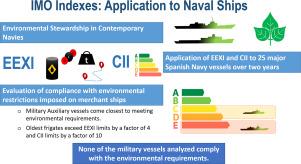Implementing IMO indices in warships: An in-depth case study in the Spanish Navy
IF 7
2区 工程技术
Q1 ENERGY & FUELS
Sustainable Energy Technologies and Assessments
Pub Date : 2025-09-30
DOI:10.1016/j.seta.2025.104604
引用次数: 0
Abstract
Contemporary navies are increasingly committed to environmental stewardship, yet no study has quantified how warships measure up to civilian green-ship standards. This article is pioneering in its use of International Maritime Organization (IMO) indicators to quantify the energy efficiency of a fleet of warships. The IMO’s Energy Efficiency Existing Ship Index (EEXI) and Carbon Intensity Index (CII) have been adapted to 25 major Spanish Navy ships over a two-year period (Dec. 2019–Dec. 2021). These indices were originally designed for merchant vessels. A combination of fuel consumption data with displacement and speed-dependent consumption curves was utilized to reconstruct each vessel’s EEXI and annual CII under both typical and full-load scenarios. It is evident that none of the warships in question satisfied the IMO’s requisite EEXI. Indeed, the most antiquated gas-turbine frigates exceeded the EEXI limit by a factor of four and the CII threshold by up to ten. In contrast, naval tankers and transport ships exhibited the closest proximity to the prescribed values, with deviations within the range of 20%–30%. The findings (25 ships; 24 months; 4–10 overrun) indicate a significant efficiency disparity and establish a robust framework — combining IMO indices with customized consumption models — for benchmarking military fleets globally.

在军舰上实施IMO指数:西班牙海军的深入案例研究
当代海军越来越致力于环境管理,但没有研究量化军舰如何达到民用绿色船舶标准。本文率先使用国际海事组织(IMO)的指标来量化军舰舰队的能源效率。国际海事组织的能源效率现有船舶指数(EEXI)和碳强度指数(CII)已在两年时间内(2019年12月至2019年12月)适应了25艘西班牙海军主要舰艇。2021)。这些指数最初是为商船设计的。将燃油消耗数据与排量和速度相关的消耗曲线相结合,用于重建每艘船在典型和满载情况下的EEXI和年度CII。很明显,没有一艘有问题的军舰满足IMO的必要EEXI。事实上,最过时的燃气轮机护卫舰超过了EEXI限制的四倍,超过了CII阈值的十倍。相比之下,海军油轮和运输船表现出最接近规定值,偏差在20%-30%的范围内。研究结果(25艘船;24个月;4-10次超支)表明了显著的效率差异,并建立了一个强大的框架——将IMO指数与定制消费模型相结合——用于对全球军事舰队进行基准测试。
本文章由计算机程序翻译,如有差异,请以英文原文为准。
求助全文
约1分钟内获得全文
求助全文
来源期刊

Sustainable Energy Technologies and Assessments
Energy-Renewable Energy, Sustainability and the Environment
CiteScore
12.70
自引率
12.50%
发文量
1091
期刊介绍:
Encouraging a transition to a sustainable energy future is imperative for our world. Technologies that enable this shift in various sectors like transportation, heating, and power systems are of utmost importance. Sustainable Energy Technologies and Assessments welcomes papers focusing on a range of aspects and levels of technological advancements in energy generation and utilization. The aim is to reduce the negative environmental impact associated with energy production and consumption, spanning from laboratory experiments to real-world applications in the commercial sector.
 求助内容:
求助内容: 应助结果提醒方式:
应助结果提醒方式:


